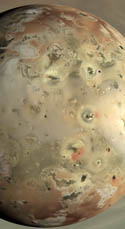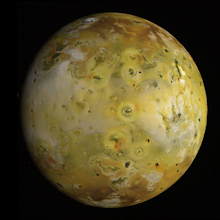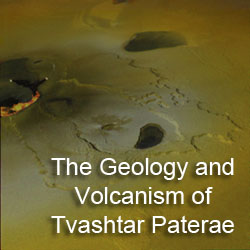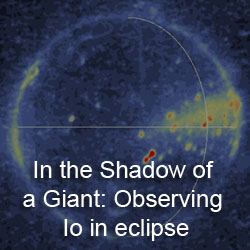Geology
 Gish Bar Patera is a volcanic depression located on Io's leading hemisphere at 16.2° North, 90.3° West. The depression has an irregular shaped, as wide as 146 kilometers (91 miles) in the north-south direction and 131 kilometers (81 miles) in the east-west direction. The margins of the patera present signs of terracing along the patera walls as well as multiple floor levels, suggesting either multiple collapse events (akin to the volcanic crater atop Olympus Mons) or post-formation mass wasting of the patera wall and several volcanic sills, respectively. Compared to Chaac Patera, a volcano discussed here in January, Gish Bar is a shallower depression, with a floor only 500 meters below the surrounding plains.
Gish Bar Patera is a volcanic depression located on Io's leading hemisphere at 16.2° North, 90.3° West. The depression has an irregular shaped, as wide as 146 kilometers (91 miles) in the north-south direction and 131 kilometers (81 miles) in the east-west direction. The margins of the patera present signs of terracing along the patera walls as well as multiple floor levels, suggesting either multiple collapse events (akin to the volcanic crater atop Olympus Mons) or post-formation mass wasting of the patera wall and several volcanic sills, respectively. Compared to Chaac Patera, a volcano discussed here in January, Gish Bar is a shallower depression, with a floor only 500 meters below the surrounding plains.Volcanism on the floor of the patera is focused in two areas: a large flow field in the north, west, and central portions of the volcano to the northwest and a possible lava lake within the southeast portion of the patera. The flow field consists of multiple flow lobes, suggesting that this portion of the patera consists of a compound flow field similar to Amirani. These flow lobes have different albedos and colors, suggesting a spectrum of surface ages or possibly different compositions. A bright orange flow in the northern potion of the patera is a possible sulfur lava flow. The other flows are consistent with the deposition of sulfur and sulfur dioxide on a cooling lava crusts of different ages. As we shall see a little later, dark, fresh flows have been observed in this flow field from orbit to orbit, while older flows fade. The southeastern end of the patera consists of a possible lava lake, 62 by 25 kilometers (38 by 16 miles) in size, with evidence for overflow events from three lava flows exterior to it. The sharp boundaries of this area suggests topographic control for the material in it, consistent with the lava lake interpretation.
To the north of Gish Bar Patera is an 11-km (36,000-foot) tall mountain named Gish Bar Mons. Gish Bar Patera and the volcano north of the mountain, Estan Patera, both appear to have led to increased mass wasting on the north and south sides of the structure. Despite this, very little debris from the mountain is apparent in the northern end of Gish Bar Patera. However, large landslides are visible to the west of the mountain, suggesting at least some degradation as the top layers of the shallow-sloped side of it sloughed off.
Volcanic History
Volcanic activity was first observed at Gish Bar Patera in the form of a thermal hotspot by the NIMS instrument during Galileo's first orbit on June 26, 1996 (orbit G1). It was also observed as a low-intensity, near-infrared hotspot in November 1996 (C3) and September 1997 (C10). Perhaps the most intense eruption of Gish Bar Patera during Galileo's nominal mission occurred in December 1996 (E4), when the SSI camera observed an intense hotspot at the volcano in an observation of Io while the moon was in the shadow of Jupiter. Jani Radebaugh, for her dissertation, correlated Galileo's eclipse observations with Io's surface features. Assuming the twist angle of the camera is correct, her E4 results suggest that the southwestern and central portions of the patera were the source of the eruption. E4 and later C10 sunlit images revealed small, dark flows in these areas, though it is possible they predate the December 1996 eruption as no images with sufficient resolution to resolve them exist before it.
The next Gish Bar imaging opportunity for Galileo was during the C21 non-targeted encounter on July 2, 1999. Gish Bar was imaged in three-colors at a resolution of 2.6 km/pixel in the violet and IR-756 filters and 1.3 km/pixel for the green filter (used in the graphic above). No surface changes are clear in the C21 data (compared to the clear-filter frame taken almost two years earlier), except for a new dark spot on the eastern wall of the southeastern "sub-patera". This is consistent with the lack of observed thermal activity at Gish Bar between September 1997 and July 1999.
 In late 1999, Galileo flew by Io twice, on October 11 then on November 25. During the October flyby (I24), Galileo observed Gish Bar at 500 meters per pixel, shown above at full-resolution in the Geology section above. Two notable changes, shown in the ratio image at right, had occurred at Gish Bar Patera between the July and October 1999. Much of the southeastern "sub-patera" had darkened except for a small "island" area. Within the flow field in the center of the patera, a fresh, 22-kilometer long, 3-kilometer wide, lava flow was also visible. A possible origin for this fresh lava was an outburst eruption that occurred on August 2, 1999. However, the low spatial resolution of the available ground-based data makes it difficult to assign a specific volcano to the eruption. Within the Galileo AMSKGI01 mosaic, no other major changes are visible that would be consistent with such a major eruption, but the terrain to the east of Gish Bar was not covered in October 1999 to provide additional comparisons with the pre-eruption images from C21. However, the amount of fresh lava covering the floor of the lava lake (or "sub-patera") and the new flow lobe would be consistent with such a major outburst.
In late 1999, Galileo flew by Io twice, on October 11 then on November 25. During the October flyby (I24), Galileo observed Gish Bar at 500 meters per pixel, shown above at full-resolution in the Geology section above. Two notable changes, shown in the ratio image at right, had occurred at Gish Bar Patera between the July and October 1999. Much of the southeastern "sub-patera" had darkened except for a small "island" area. Within the flow field in the center of the patera, a fresh, 22-kilometer long, 3-kilometer wide, lava flow was also visible. A possible origin for this fresh lava was an outburst eruption that occurred on August 2, 1999. However, the low spatial resolution of the available ground-based data makes it difficult to assign a specific volcano to the eruption. Within the Galileo AMSKGI01 mosaic, no other major changes are visible that would be consistent with such a major eruption, but the terrain to the east of Gish Bar was not covered in October 1999 to provide additional comparisons with the pre-eruption images from C21. However, the amount of fresh lava covering the floor of the lava lake (or "sub-patera") and the new flow lobe would be consistent with such a major outburst.Gish Bar was observed again by Galileo during a pair of flybys in 2001, on August 6 (I31) and October 16 (I32). While high-resolution camera images were not obtained in the August flyby due to a camera malfunction, the near-infrared spectrometer acquired an observation of Gish Bar with a resolution of approximately 7.3 kilometers per pixel. This data revealed thermal emission within the lava lake and across parts of the flow field. However, most of the emission was at longer wavelengths, consistent with cooled lava flows. The shorter wavelength data provides the highest resolution data of the volcano between October 1999 and October 2001. No surface changes are apparent, though it would appear that many of the flows on the floor of Gish Bar had faded since October 1999.
 Two months later, Galileo's camera observed Gish Bar once again, this time at 250 meters per pixel. A fresh lava flow, 1430 square kilometers in size, was visible across much of the western half of the patera. This covered much of the green colored terrain seen in the C21 color data. The flows seen in the center of the patera in the C21 and I24 data had faded due to inactivity and later sulfur deposition as the flows cooled. The lava lake was still covered mostly with dark material, suggesting continued activity after October 1999. The fresh lava flow observed at Gish Bar is thought to have formed sometime after the August 2001 flyby, as a significant increase (two orders of magnitude in emitted power) in Gish Bar's thermal emission was observed by NIMS during the I32 flyby, and the flow was not seen in the NIMS short-wavelength data in August. Assuming the eruption started shortly after the I31 flyby, the average coverage rate for the eruption was 230 square meters per second, similar to the coverage rate inferred for the Pillan eruption in 1997 or twice Kilauea's coverage rate at its peak. This was a major eruption indeed! Marchis et al. detected a hotspot using the Keck telescope in December 2001, showing that the eruption continued at least another couple of months.
Two months later, Galileo's camera observed Gish Bar once again, this time at 250 meters per pixel. A fresh lava flow, 1430 square kilometers in size, was visible across much of the western half of the patera. This covered much of the green colored terrain seen in the C21 color data. The flows seen in the center of the patera in the C21 and I24 data had faded due to inactivity and later sulfur deposition as the flows cooled. The lava lake was still covered mostly with dark material, suggesting continued activity after October 1999. The fresh lava flow observed at Gish Bar is thought to have formed sometime after the August 2001 flyby, as a significant increase (two orders of magnitude in emitted power) in Gish Bar's thermal emission was observed by NIMS during the I32 flyby, and the flow was not seen in the NIMS short-wavelength data in August. Assuming the eruption started shortly after the I31 flyby, the average coverage rate for the eruption was 230 square meters per second, similar to the coverage rate inferred for the Pillan eruption in 1997 or twice Kilauea's coverage rate at its peak. This was a major eruption indeed! Marchis et al. detected a hotspot using the Keck telescope in December 2001, showing that the eruption continued at least another couple of months.Conclusion
Gish Bar Patera displays some fairly unique behavior for a volcanic depression. The patera itself is one of the largest on Io, large enough to have different portions of the volcano display different eruption styles. The southeastern potion of Gish Bar appears to consist of a large lava lake. Much of the rest of the patera floor is covered by a lava flow field, not unlike Amirani or Prometheus, that is topographically confined by the walls of the patera. The flow field is built up by multiple flow lobes, that form during major eruptions that occur every few years. Thus, unlike Amirani and Prometheus, Gish Bar is not persistently active. Its multi-colored surface and the adjacent mountain, Gish Bar Mons, make this region a compact version of many of the geologic themes that are common on Io. It certainly makes it one of the most fascinating features on Io, and that's why I presented a poster about it seven years ago, and that's why I named my Io blog after it.
Link: Gish Bar Patera, Io: Geology and Volcanic Activity, 1996-2001 [www.lpi.usra.edu]












No comments:
Post a Comment